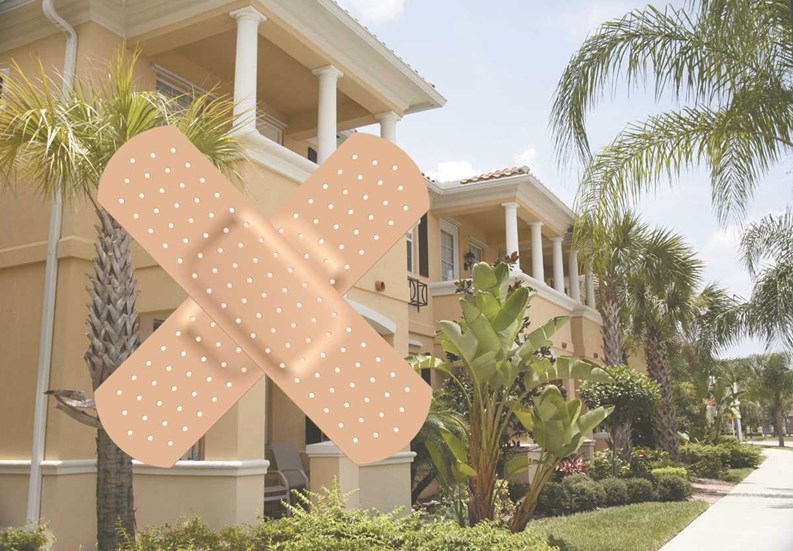Descriptions of “vintage,” “refurbished” and “pre-owned” can persuade the decision toward some purchases—cars, computers, that perfect James Dean-era leather jacket—but for South Florida homebuyers, the allure of shiny and new is often too hard to ignore. Moving into a brand-new building or even a gut rehab certainly has its benefits, but there are also plenty of downsides to buying new units. Smart buyers brush up on these potential pitfalls before finding themselves in a money pit. And if it’s too late for that, then there are certain courses of action that can help recoup some losses.
At the height of the real estate boom in the mid-2000s, developers built quickly to keep pace with demand. That was good for eager buyers—and not so good for eager buyers. Some developers got into the game simply to make money, rather than provide a lasting product. Speedy delivery coupled with some sketchy oversight has led to problems with new-construction homes. “Whenever there is a building boom, builders become more interested in building projects quickly than in building them correctly,” says Matthew J. Johnson, managing partner at the Florida office of Condo Defects Law Group, LLP.
The most common problems involve water leakage, and it’s not necessarily detectable when someone’s looking at a building with wide-eyed buyer’s eyes. It might be due to flashing that’s left unfinished or done incorrectly at roofs, parapet walls, and windows; downspouts incorrectly tied into sewer lines; or problems with flooding in lower units and basements.
A thorough pre-sale inspection should catch some of these things but doesn’t always. For instance, sometimes a condo building’s roof isn’t easily accessible or the developer of the new building purposefully prevents access to avoid discovery of problems. In other cases, the developer actually may linger in control of the association board, making it difficult to find problems, and then leave the board without the reserves to pay for repairs.
Oscar Garcia, district manager of KW Property Management, based out of Miami, is currently dealing with a situation like this. “The developer resigned from the board, and not only has he not set up reserves, he did not fix the problem and walks away from it, leaving them empty-handed with no money to sue him,” he says. “I’m encouraging them to do a bake sale, have a sidewalk sale, a car wash, collect funds to get a post-engineering report.” Garcia’s goal is to at least begin the process of approaching the developer to do the right thing.
While water penetration is typically the most expensive issue to correct, there are other big ones. “All sorts of defects,” says Jay Steven Levine, founder of Jay Steven Levine Law Group in Palm Beach and Broward County. He’s talking everything from leaking roofs to faulty air conditioners to landscaping with invasive roots that lift up driveways, foundations and sidewalks. In homeowners associations, Levine often sees road compaction problems as well, along with drainage problems on roads or within condos.
Marc Mallet, LCAM, the director of field operations and a property manager with Miami area-based Atlantic | Pacific Management, also points to problems with hairline structural cracks that appear after the building has settled. In South Florida, any newly constructed residence is bound to have a pool, which can also present structural cracking issues.
From Better to Worse?
Through the past decades, some building codes and components have improved, such as hurricane-impact glass and standardized hurricane shutters, but in many cases older buildings are still sturdier. “With buildings 40 to 50 years old, like a car, as long as you’ve been changing the oil, they’re going to last,” Garcia says. “You could sit through a hurricane and the windows might blow out, but we could hold onto the door frame,” he says.
Although the building codes are in place to insure safety and structural integrity, enforcing them can be difficult especially during a building boom. While a building official may approve a certificate of occupancy, there’s still potential for in-field errors and shortcuts that can lead to problems later. Structures built during the boom of the early 2000s were “pushed through the process,” Garcia says. In turn, this led to decreased supervision on job-sites and, therefore, increased problems.
“If [the building department] is short-staffed, the review time is less,” Levine notes. “I would think that they’re not going to catch everything, and for a developer to say, ‘We got the [certificate of occupancy] and the government is perfectly happy with us,’ is not necessarily the case.” Even though there’s less construction taking place now, Levine warns that this still may not mean better oversight because there may be fewer inspectors.
Quality also suffers in some cases due to poorly trained workers because developers are so bent on getting the work done that they hire subcontractors that they may not routinely hire, Johnson explains. Plus, during the height of building, some general contractors jumped on the developer bandwagon, thinking they could make a quick buck, but not realizing the intricacies of the process. Overall, Levine says that newer construction may be better because of better codes, but, he says “it’s up to the contractor to do a good job.”
Looking at the Law
There are state and municipal construction codes that regulate building, but, as mentioned, unscrupulous developers sometimes thumb their noses at these codes, knowing that the chances at getting caught are low. Plus, it’s important to note that building departments cannot legally be held liable for construction defects, which certainly makes sense to some degree, considering their high case load and low staff numbers. Unfortunately, this poses a possibly unintended effect. “Their incentive to do a good job is limited because they are usually immune from liability, even when they approve construction that is not compliant with applicable building codes,” Johnson says.
When problems present themselves after an owner moves in, the finger-pointing begins, and it can be hard to catch the culprit. Because a unit owner in a new building purchases from the developer, most of the blame falls to the developer who can quickly make himself scarce. For each project, developers typically create a separate LLC, which they dissolve after the units are sold off. Next in line in the blame game are general contractors and subcontractors. “While the problem may originate with the subcontractor, the general contractors contribute to the problem by failing to adequately supervise their subcontractors,” Johnson says. “Often, developers act as their own general contractor and in this event, they have a heightened responsibility to supervise the subcontractors,” he adds.
Making a Plan of Attack
The key to successful litigation against a developer is to act quickly because in any case, recourse for homeowners relies on some statutes of limitations, which begin after the date of turnover from the developer to the unit owners. You have four years to make claims on construction defects from the time the problem is discovered, which includes the discovery of latent defects, in which case the clock begins at the time the association should have known about the defect. However, there is a 10-year statute of repose, meaning, Johnson explains, “If a project is more than 10 years old, a claim may be barred regardless of when the claimant knew or should have known of the defects.” In other words, if an association ignores signs of a potentially significant defect, the clock is still running on that 10-year limit.
Still, there are exceptions to the rules, and it may be worth discussing particular cases with a lawyer before assuming it won’t be covered. “The analysis related to the statute of limitations is typically a fact issue based on the specific circumstances of the individual project,” Johnson says. He also suggests that, no matter the problem, a unit owner should probably first complain to the association. But Johnson points out, “Owners also have rights that can be asserted against the developer and the contractors responsible for creation of the defects.”
Protection Against Defects
Before signing on the dotted line, a little due-diligence can go a long way. “The best protection against defective construction is probably to purchase from a well-established developer with a reputation for standing behind its work product,” Johnson advises.
Garcia warns against buying sight unseen over the Internet as well. “People think, ‘I’m buying a unit in South Beach, even if it’s falling apart,’” he says. However, not only may they not understand the extent to the construction issues but they don’t understand the lien process when a unit is not built to code. “They really need to get financials, ask neighbors, inspect. Don’t let the blue-light sale scare you into buying it.”
Go see the unit in person before trusting a sales pitch. Then be on the lookout for things like settlement cracks and water stains on ceilings and around windows. “Smell to see if there is any dampness in the air,” suggests Mallet. “Go to the balcony and shake the railing to see if it is sturdy and that they’re deep within the slab pockets.” He also advises to open glass sliding doors to check their operation; examine frames around the doors and windows for signs of moisture, and to look closely for any signs of rust or droplets of water indicating condensation. Plus, open the air-conditioning unit to check for the date of installation and rusting around the unit; and open the electrical circuit breaker panel to check for signs of corrosion or rusting; flush the toilets and run water in the sinks, and look under sinks for water leakage. And, he adds, “Lastly, take a general look around walls and ceilings in the rooms to look for things out of the norm.”
After turnover of the building from the developer, Johnson also recommends getting a report done on the building envelope. Although this can cost some money upfront, it can discover problems early on, allowing a follow-up with the developer sooner than later and potentially avoiding more costly repairs down the line. This report is on top of a developer’s initial report. “The developers don’t have an incentive to find problems,” Johnson reminds owners. “A third party investigator may open a wall or, if there’s a roof leak, pull some roof off to see if it’s a systemic problem.”
It may all seem like overkill but it’s definitely a buyer-beware situation. Don’t be wooed by the fancy façade just to discover that it’s all skin deep.
Elisa Drake is a freelance writer and a frequent contributor to The South Florida Cooperator.







Leave a Comment